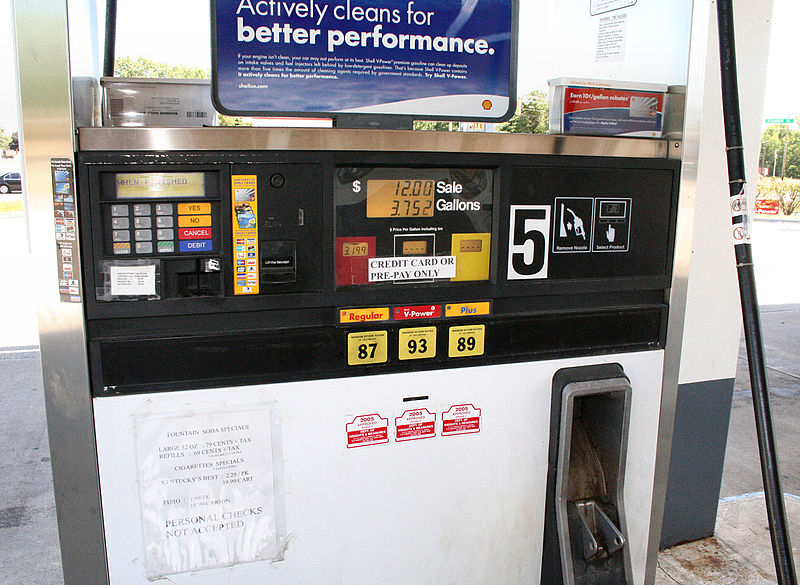On Monday, I drove across state lines and deep into Hammond, Indiana to spend $3.97 per gallon on a full tank of gas for my SUV. When my husband came home from work, I excitedly told him that I paid less than $4 per gallon for gas. Then I froze as I realized that I was just celebrating about paying a price that was more than 3 times the price per gallon I remember from when I first started driving 12 years ago. This is madness! It would be great to just bike or walk everywhere, or even to own an electric car that doesn't use any gas at all, like the ones mentioned in my post from last week Fuel-Efficient Cars, but those aren't really options for me at this point in my life. So, what else is there to do?
What if there were some simple ways to improve fuel economy in the cars, trucks, and SUVs that we currently own so that we use less gas and pay less at the pump? Well, you're in luck! I've done some research this week and compiled this list of ways to get better gas mileage. Some require more significant changes to your daily routine, but others are simple solutions that won't eat up much of your time. Read on and start saving today!
Ways to Get Better Gas Mileage
Drive Your Most Fuel-Efficient Vehicle
If you're like my family, you may have your choice of vehicles. Look up their gas mileage online, or calculate your gas mileage by dividing the number of miles you traveled since filling the tank the last time by the number of gallons it takes to fill the tank when you next go to the pump. If one of your cars gets better mileage than the others, try to make most of your trips using the most fuel-efficient car at your disposal. For me, that means my husband and I run errands in his 1966 Volkswagen Beetle when the weather permits rather than driving my Chevy Blazer around town.
Change Your Commute
Check with your company to see whether they will allow you to telecommute some of the time. If this is not possible, see if you can change your schedule so that you do not have to drive during rush hour traffic. Repeated starting and stopping in heavy traffic leads to poor fuel economy. You'll get better gas mileage if you commute during times that the traffic is moving. For your commute, try to choose routes that have less stop signs and stop lights. When you drive at a steady speed without frequent stops or widely varied speeds, your gas mileage will improve.
Carry Only What You Need
For everyday driving, make sure you're carrying only what you need. According to the U.S. Department of Energy, carrying an extra 100 pounds of belongings inside the cabin or trunk of your vehicle reduces your car's gas mileage by 1 to 2 percent. On long road trips, try to avoid carrying a "burger box," canoe, or other object on the roof of your vehicle. When you haul things on the roof, your car catches more wind and has to fight harder against the air currents, which means you will have worse gas mileage than you would without that extra item on the roof.
Drive Sensibly
Avoid aggressive driving, such as speeding, rapid acceleration, or constant weaving and slamming of the brakes. Aggressive driving uses more gas than steady and slow acceleration, coasting as you approach a stop, and maintaining an even speed whenever possible. By driving sensibly and calmly, you can improve your gas mileage by up to 33 percent at highway speeds and 5 percent around town, according to the U.S. Department of Energy.
Travel at Efficient Speeds
According to a study done by the U.S. Department of Energy, most cars get optimal gas mileage between 40 and 60 miles per hour. If possible, choose routes that will allow you to drive at speeds within that range. When you're on the highway or interstate, try to avoid driving faster than 60 miles per hour. The study states that maintaining a steady speed between 40 and 60 miles per hour improves your gas mileage by 7 to 23 percent, which is like saving $0.27 to $0.89 per gallon of gas if the average price is $3.87 per gallon.
Avoid Idling for Long Periods of Time
If you're waiting for your children to get out of school or stuck for what seems like a century at a railroad crossing, turn off your vehicle. Turing your car off while you wait and then starting the engine again once its time to start moving can save you up to 4 cents a minute. That might not sound like much, but if you spend a total of 30 minutes a day waiting for someone or waiting on a train 5 days a week, you would save $6 per week, or $312 per year. Not too shabby!
Use Cruise Control or Overdrive
If your car is equipped with cruise control or overdrive, use them whenever possible. Cruise control helps you maintain constant speeds and nearly always increases fuel economy. Overdrive slows the speed of your engine, known as RPM, which means better gas mileage and less wear on your engine.
Keep Your Engine Tuned
Just as a person generally incurs less hospital bills in a given year by taking vitamins, eating healthy, and doing what is needed to stay well, your car will run better, use less gas, and require less repairs if you maintain it properly. This means getting the oil changed every 3,000 miles (or as recommended by the manufacturer or brand of oil you are using), checking regularly to see that your brakes are working properly and that you have the correct amount of brake fluid, transmission fluid, oil, and coolant in your car, and fixing any known problems as soon as you learn of them, such as replacing a faulty oxygen sensor. Keeping your car healthy and in shape can improve your gas mileage by 4 to 40 percent, depending on the types of issues that pop up. It can also save you countless dollars in repair bills and rental car fees.
Check Your Tire Pressure
Look for a sticker on your car, usually in the driver's side door jamb or inside the glove compartment, that tells you the recommended air pressure level for your vehicle's tires. Once you learn this number, check periodically to make sure your tires have the recommended amount of air in them. An air pressure gauge costs a few dollars at the store, and some gas stations and tire centers offer free air. Keeping your tires filled properly can improve your gas mileage by up to 3.3 percent.
Use the Correct Type of Oil
There are many types, or weights, of motor oil available on the market. Some examples include 10W-30, 5W-20, and 5W-30, among others. Read the operator's manual for your vehicle to find the recommended motor oil weight for your vehicle and use that weight. Additionally, ask for motor oil labeled as "Energy Conserving." Using the proper weight of oil can improve your fuel economy by up to 2 percent.
Find the Best Gas Prices
Search for the best rates using a website like Gas Buddy. Keep in mind that you need to find the best price within reason. For example, I live in Chicago, 2 miles from the Illinois/Indiana border. I drive 4 miles to find lower gas prices and cheap groceries in Indiana. For me, the extra trip is worth it. For my friend, however, who lives 25 miles from the town where I purchase gas, she would have to drive a round trip of 50 miles, in Chicago traffic, which would use more than 2 gallons of gas in her SUV. For her, she would be better off looking for the lowest price within a few miles of her home or office.
Combine Your Errands
As mentioned in the previous example, I visit the grocery store and the gas station whenever I journey into Indiana. Some weeks, I add a trip to a Target or Walmart in that same area. Your car will get better mileage when driven on one long trip running several errands than it would running each errand from a cold start on separate occasions.
Buy Gas at the Coolest Time of Day
When the temperature of gasoline is cooler, it has greater density per volume. This may sound confusing, but what it really means is that you can get more fuel in each gallon of gasoline when you buy it during a cooler time of day than a hotter time of day.
Close that Gas Cap
Gasoline vaporizes (turns from a liquid into a gas or vapor) quickly, which can allow fuel to escape from your vehicle's gas tank if the cap is missing or isn't closed tightly enough.
Only Use Air Conditioning when Necessary
Using air conditioning decreases gas mileage about 1 mile per gallon. When possible, avoid running the air conditioner, particularly when stuck in traffic or travelling at slow speeds with frequent stops.
Get Going Right Away
Unless the weather is particularly cold, or you drive a classic car, start driving as soon as you start your car. Modern engines don't need much time to warm up and often warm up better while moving than while sitting at an idle. CAUTION: During extreme cold, it is still advisable to allow the engine to warm up for a few minutes before driving to avoid breaking or damaging parts made brittle by the cold.
Avoid Accelerating Up Hill
Whenever possible, avoid accelerating (or rapid acceleration) while driving up hill. This provides an obvious strain on your vehicle and uses more gas. Instead, try to maintain a constant pressure on the gas pedal and accelerate once you reach the top.
I hope these tips help you save at the pump. Do you know of any other ways to save on gas? If so, use the form below to submit a comment and see your input added to this site.
~Jenn



